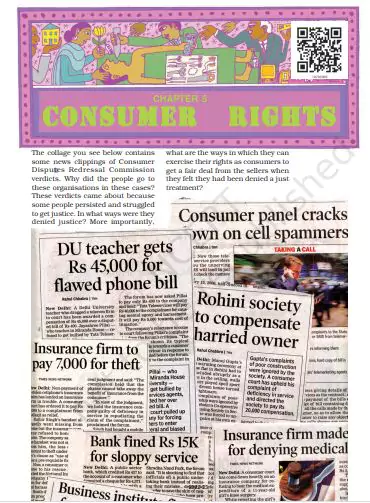‘NCERT Solutions for Class 10 Social Science Chapter 5 Consumer Rights‘ PDF Quick download link is given at the bottom of this article. You can see the PDF demo, size of the PDF, page numbers, and direct download Free PDF of ‘Ncert Class 10 Social Science Chapter 5 Exercise Solution’ using the download button.
Consumer Rights Book PDF Free Download

Chapter 1: Consumer Rights
We participate in the market both as producers and consumers. As producers of goods and services we could be working in any of the sectors discussed earlier such as agriculture, industry, or services. Consumers participate in the market when they purchase goods and services that they need.
These are the final goods that people as consumers use. In the preceding chapters we discussed the need for rules and regulations or steps that would promote development. These could be for the protection of workers in the unorganised sector or to protect people from high interest rates charged by moneylenders in the informal sector. Similarly, rules and regulations are also required for protecting the environment.
For example, moneylenders in the informal sector that you read about in Chapter 3 adopt various tricks to bind the borrower: they could make the producer sell the produce to them at a low rate in return for a timely loan; they could force a small farmer like Swapna to sell her land to pay back the loan. Similarly, many people who work in the unorganised sector have to work at a low wage and accept conditions that are not fair and are also often harmful to their health.
To prevent such exploitation, we have talked of rules and regulations for their protection. There are organisations that have struggled for long to ensure that these rules are followed. THE CONSUMER IN THE MARKETPLACE Likewise, rules and regulations are required for the protection of the consumers in the marketplace.
Individual consumers often find themselves in a weak position. Whenever there is a complaint regarding a good or service that had been bought, the seller tries to shift all the responsibility on to the buyer. Their position usually is – “If you didn’t like what you bought, please go elsewhere”. As if the seller has no responsibility once a sale is completed! The consumer movement, as we shall discuss later, is an effort to change this situation.
Exploitation in the marketplace happens in various ways. For example, sometimes traders indulge in unfair trade practices such as when shopkeepers weigh less than what they should or when traders add charges that were not mentioned before, or when adulterated/defective goods are sold. Markets do not work in a fair manner when producers are few and powerful whereas consumers purchase in small amounts and are scattered. This happens especially when large companies are producing these goods.
These companies with huge wealth, power and reach can manipulate the market in various ways. At times false information is passed on through the media, and other sources to attract consumers. For example, a company for years sold powder milk for babies all over the world as the most scientific product claiming this to be better than mother’s milk. It took years of struggle before the company was forced to accept that it had been making false claims.
Similarly, a long battle had to be fought with court cases to make cigarettemanufacturing companies accept that their product could cause cancer. Hence, there is a need for rules and regulations to ensure protection for consumers. Reji’s suffering shows how a hospital, due to negligence by the doctors and staff in giving anaesthesia, crippled a student for life. While using many goods and services, we as consumers, have the right to be protected against the marketing of goods and delivery of services that are hazardous to life and property.
Producers need to strictly follow the required safety rules and regulations. There are many goods and services that we purchase that require special attention to safety. For example, pressure cookers have a safety valve which, if it is defective, can cause a serious accident.
The manufacturers of the safety valve have to ensure high quality. You also need public or government action to see that this quality is maintained. However, we do find bad quality products in the market because the supervision of these rules is weak and the consumer movement is also not strong enough.
| Author | NCERT |
| Language | English |
| No. of Pages | 19 |
| PDF Size | 2.7 MB |
| Category | Social Science |
| Source/Credits | ncert.nic.in |
NCERT Solutions Class 11 Social Science Chapter 5 Consumer Rights
Question 1: Why are rules and regulations required in the marketplace? Illustrate with a few examples.
Answer:
Rules and regulations are required in the market place due to the following reasons :
- The consumers are exploited by the shopkeepers and traders in different ways such as less weight or measurement, more price, adulterated and defective goods.
- In case of a complaint regarding a good or service, the shopkeeper or trader tries to avoid any responsibility. The seller tries to shift all the responsibility onto the buyer as if the seller has no responsibility once a sale is completed.
- Sometimes producers are few and powerful while the consumers purchase in small amounts and are scattered. Big companies with huge wealth manipulate the market in many ways.
- At times false information is passed on through the media, and other sources to attract consumers. For example, a company for years sold powder milk for babies all over the world as the most scientific product claiming this to be better than mother’s milk. It took years of struggle before the company was forced to accept that it had been making false claims. Similarly a long battle was fought with the cigarette manufacturing companies to accept that their product could cause cancer. Hence there is a need for rules and regulations to ensure protection for consumers.
Question 2: What factors gave birth to the consumer movement in India? Trace its evolution?
Answer:
The factors that gave birth to the consumer movement in India are manifold. It started as a “social force” with the need to protect and promote consumer interests against unfair and unethical trade practices. Extreme food shortages, hoarding, black marketing and adulteration of food led to the consumer movement becoming an organised arena in the 1960s. Till the 1970s, consumer organisations were mostly busy writing articles and holding exhibitions.
More recently, there has been an upsurge in the number of consumer groups who have shown concern towards ration shop malpractices and overcrowding of public transport vehicles. In 1986, the Indian government enacted the Consumer Protection Act, also known as COPRA. This was a major step in the consumer movement in India.
NCERT Class 11 Social Science Textbook Chapter 5 With Answer PDF Free Download
